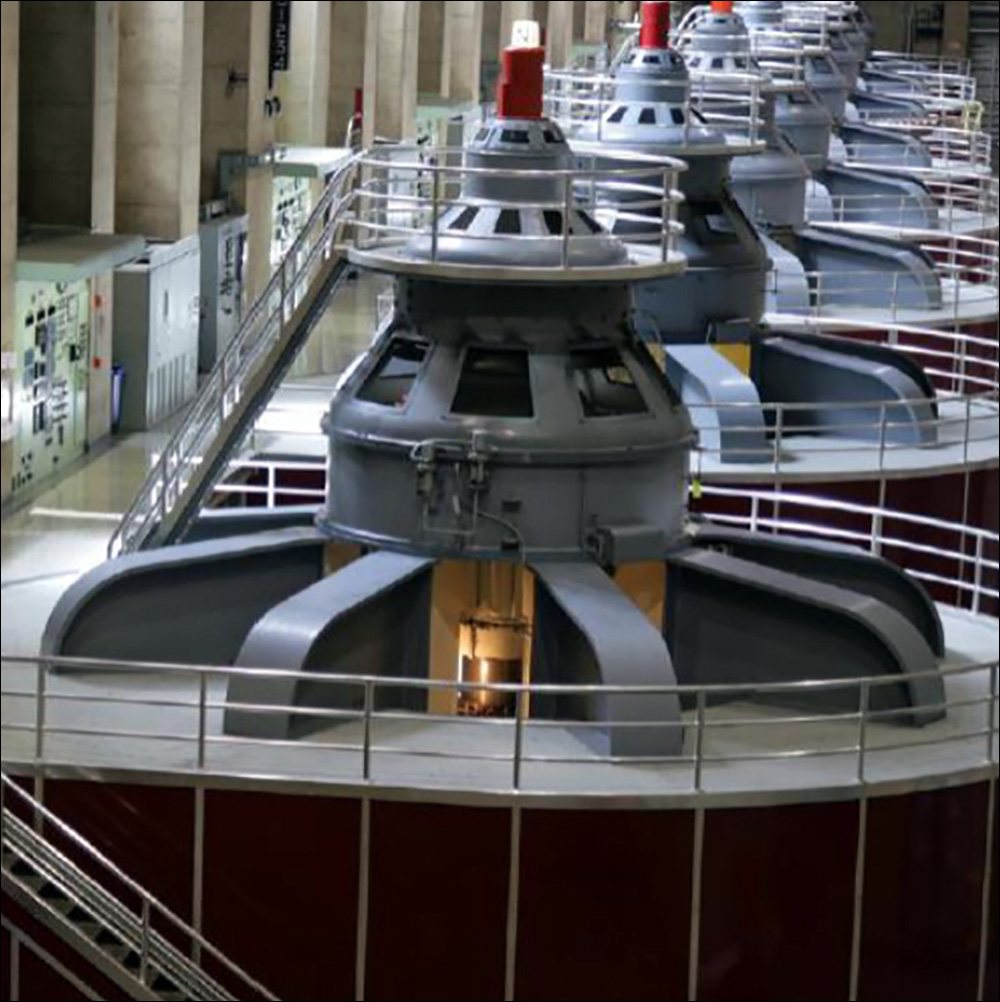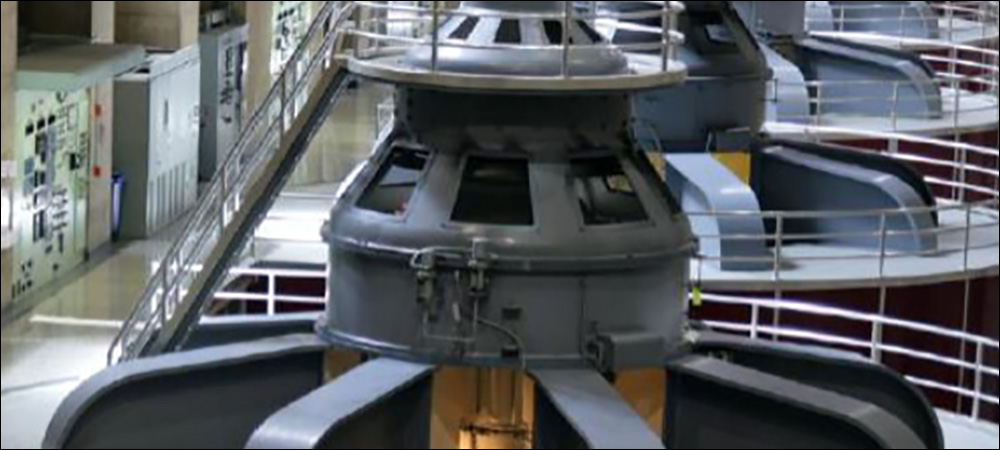- Third-Generation Tag Being Tested
- Rotating at 800 Turns Per Minute
- Managing Preventative Maintenance
GE Hydro, global energy company GE‘s Renewable Energy division, is headquartered in Grenoble, France. The firm has expanded a pilot of RFID-based wireless sensors to track the conditions around its spinning parts within the generators, in order to obtain strain-management and temperature data. The tags are attached to rods (also known as salient poles) that spin around rotators, and they transmit conditions, leveraging power from the RFID technology, thereby eliminating the need for wires or batteries.
The system deploys HID Global‘s customized RFID tags with Asygn‘s sensor chips and Impinj‘s RFID readers with antennas from SensThys. GE Hydro’s own software-management system captures sensor data liked to dozens of poles in each rotor, enabling it to detect any potential failures or the need for servicing on the power-generating equipment.

The turbines come with rotors and poles that are submerged and spin with the movement of water flowing around them, generating electricity.
The customized RFID tag and full solution enables the renewable utility company to optimize power generation based on data related to when each rotor is working at its best, or when the load may be too high. The system is being tested at GE Hydro’s sites in Canada and France (the company declines to specifically name those sites), and the piloting is slated to continue throughout this year.
The solution results from extensive engineering on the part of HID and Asygn to create a sensor label that not only captures sensor data but transmits that information reliably at high speed, as the tags are attached to salient poles that spin at a rate of 800 rotations per minute. They must transmit at a high speed while rotating past a fixed reader, and they must do so in an environment containing metal and water. The company’s goal is to optimize availability and prevent unplanned outages, according to Christian Mirus, HID Global’s IoT business-development manager.
Third-Generation Tag Being Tested
The project was launched in 2018 when the company sought a technology-based solution to gain a real-time view into the health of its rotors and thereby reduce the risk of them failing unexpectedly, by providing data about the equipment’s conditions. If the rotors increase in temperature, for instance, that could indicate a potential mechanical problem that might lead to damage to the entire system, or that could require a shutdown for repair.

Christian Mirus
“When you stop this kind of machine,” Mirus explains, “you may have to stop it for weeks to do maintenance,” during which the power generation can be affected. Since the launch, HID has worked with Asygn to create three generations of the tag, and Mirus says those installed at the two facilities are operating successfully (see General Electric to Pilot Battery-free RFID Sensors in its Hydro Turbines).
Asygn makes UHF RFID sensor chips that detect a variety of conditions and transmit the resulting data leveraging the power received from an RFID reader. The single chip can measure multiple conditions and respond to interrogation by most standard EPC UHF RFID readers. HID built an on-metal RFID tag in which the Asygn chip is embedded, customizing the tag’s antenna to operate in the unique conditions of a hydroelectric plant. This year, GE Hydro wanted to expand the solution to track strain.
“With the second phase of the trial,” Mirus states, “we are not only providing the temperature but also measuring the strain on connection between the rotor poles.” Each turbine comes with rotors and a series of poles connected to those rotors that are submerged and spin with the movement of the water flowing around them, generating electricity. The connectors being monitored for temperature and strain are located above the water, while HID’s tags are attached inside these connectors to each pole.
The environment poses unique challenges for RFID technology. First, the tags are exposed to temperatures exceeding 100 degrees Celsius (212 degrees Fahrenheit). Therefore, HID’s engineers built the on-metal tag to not only sustain heat, but also transmit with the same reading distance—approximately 1.5 meters (4.9 feet)—whether or not they are exposed to the high temperatures.
Rotating at 800 Turns Per Minute
Another challenge was to affix each tag with the chip positioned to measure the temperature and strain on the pole, rather than other material around it. The tag is designed for mounting directly on metal, with the chip positioned against the metal surface being tracked.
The greatest challenge, however, may involve the spinning of the rotor. The system rotates at a rate of 800 turns per minute, providing approximately 10 milliseconds for the reader to transmit power to energize the chip, then receive the chip’s sensor readings. The tag antennas are optimized to transmit in this environment at high speed. As the reader interrogates the tag, the tag chip must receive that energy, accomplish the sensor measurements and transmit back, all within that 10-millisecond period.
By adding the strain sensor to the existing solution, GE Hydro hopes to capture more data about potential problems or equipment malfunctions. Under heat, for instance, the metal plates expand, which Mirus says can lead to an actual break. With the technology, GE Hydro hopes to detect not only those temperatures change, but also how the fluctuations affect the metal parts’ integrity. An Impinj Speedway R420 reader with SensThys SensRF-101 antennas captures EPC and UID numbers, along with additional sensor data, in a dedicated memory block for sensor readings.
Managing Preventative Maintenance
The solution not only can detect any problems taking place in real time, but it also enables the utility company to better manage preventative maintenance by tracking conditions over time. For example, by capturing data on a regular basis and detecting gradual condition changes, the RFID system could provide analytics around conditions that cause such changes, as well as monitor how quickly parts degrade and, therefore, when preventative maintenance needs to be scheduled.
That data could make it possible for scheduled maintenance to take place only when needed, as well as allow scheduling to be more targeted toward the equipment’s actual life span and conditions. In addition, the temperature and strain data could manage water flow through each turbine, ensuring that water levels do not cause unnecessary strain, and the system can adjust water flow if strain is detected.
In the long term, HID Global and Asygn plan to commercialize the wireless sensing system for use by other utility companies. They intend to make the technology available for applications in healthcare, agriculture and other sectors as well.
Key Takeaways:
- Asygn and HID developed a passive on-metal RFID tag that transmits sensor readings at high speed as rotors spin to generate hydroelectric power.
- The technology includes both sensor and temperature tracking, and HID and Asygn may commercialize the solution for other power facilities.


